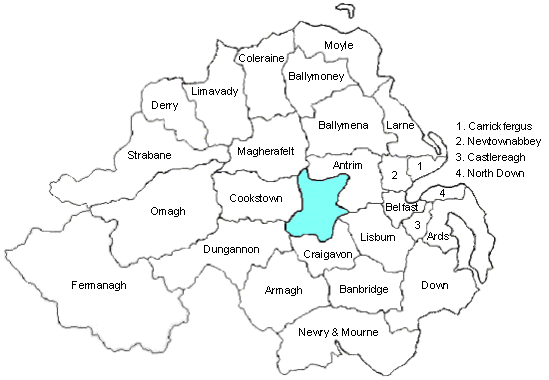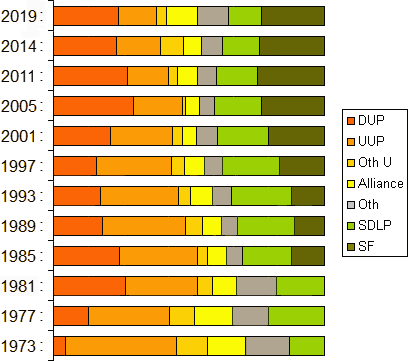

 |
 |
|
|
|
|

|
Map by Conal Kelly
The elections for Northern Ireland's 26 local councils took place on 19 May 1993. This was the sixth set of elections since the local councils were reorganised in 1973. Councillors are elected for a four-year term by Single Transferable Vote from local electoral areas returning five, six or seven councillors. You can look at all the local election results since 1973 here, and the 1997 results here.
These elections are of particular interest because the boundaries on which they were fought were new. Election boundaries for local elections in Northern Ireland are set at roughly ten-year intervals; thus the boundaries used in the first elections in 1973 were again used in 1977 and 1981; they were then revised in time for the 1985 elections, and these boundaries were again used in 1989; the 1993 boundaries were again revised, and these boundaries were used in 1997 and will be used again in the 2001 local elections.
These were the first elections I really got involved in after rejoining the Alliance Party (I had originally joined when I was at school, but had lapsed while studying at Cambridge). My memory of polling day is of handing out leaflets for Stephen Farry outside a polling station in Bangor, accompanied only by a Kilfedderite on a similar mission. Over the next two days I got to attend the Belfast counts in the City Hall, starting with Upper Falls. Having made myself useful I became Alliance's Director of Elections in September.
The results are interesting in a way because they weren't very different from those of four years before. They gave quite a false impression of a stability having been reached in the Northern Ireland party system; the Conservative challenge failed to materialise, Dem Left and the Workers Party were disappearing off the map separately rather than together, and the Ulster Popular Unionist Party would stay around until Jim Kilfedder died (though nobody expected that to happen quite as soon as it did). But in fact there was a demographic bubble about to surface, and Sinn Féin were the ones who benefited from it from 1996 (perhaps even 1994) onwards.
I have taken
my figures from Gordon Lucy's excellent book, occasionally
corrected by my personal notes.(See also spreadsheet archive.)
| UUP | 184082 | 29% | 197 cllrs |
| SDLP | 136760 | 22% | 127 cllrs |
| DUP | 108680 | 17% | 103 cllrs |
| SF | 77600 | 12% | 51 cllrs |
| Alliance | 47658 | 8% | 44 cllrs |
| Conservatives | 9438 | 1% | 6 cllrs |
| Workers Party | 4827 | 1% | 1 cllr |
| Labour | 3981 | 1% | 1 cllr |
| PUP | 2350 | 0.37% | 1 cllr |
| Dem Left | 2288 | 0.36% | 1 cllr |
| UDP | 2181 | 0.35% | 1 cllr |
| UPUP | 1730 | 0.27% | 3 cllrs |
| Greens | 1257 | 0.20% |
|
| Action 93 | 871 | 0.14% | 1 cllr |
| Independent Unionists | 19506 | 3% | 21 cllrs |
| All others | 25987 | 4% | 24 cllrs |
Total valid vote: 629,106; Percentage turnout: 55.0%
Action '93 was a coalition of independent councillors in volatile North Down.

This graph
contrasts the first preference votes across the whole of
Northern Ireland in the local government elections of 2001,
1997, 1993, 1989, 1985, 1981, 1977 and 1973.
In the table below, changes for the main parties since 1989 are indicated by + or - signs, so for instance 8-- in the box for the UUP on Antrim council indicates that this was a decrease from 10 councillors at the 1989 elections. I have not done this in the 'Others' column. Also I have not allowed for by-elections or changes of allegiance between 1989 and 1993. However I have indicated those councils where the total number of seats was increased. (NB there was no change in party strengths or total council size in Larne.)
| Council | UUP | DUP | SDLP | SF | APNI | Cons | Others | Total Seats |
| Antrim | 8-- | 3- | 4 | 1+ | 2+ | 0 | 1 Ind U | 19 |
| Ards | 9+ | 6- | 0 | 0 | 6++ | 0 | 1 Ind U, 1 Ind | 23+++ |
| Armagh | 10- | 2 | 9+ | 1 | 0 | 0 | 0 | 22 |
| Ballymena | 10+++ | 9--- | 2+ | 0 | 1 | 0 | 2 Ind U | 24+ |
| Ballymoney | 6 | 6 | 3 | 0 | 0 | 0 | 1 Ind | 16 |
| Banbridge | 10+ | 2 | 3 | 0 | 1+ | 0 | 1 Ind | 17++ |
| Belfast | 15+ | 9+ | 9+ | 10++ | 5- | 0 | 1 PUP, 2 Ind U | 51 |
| Carrickfergus | 5+ | 2- | 0 | 0 | 6++ | 1 | 3 Inds | 17++ |
| Castlereagh | 6 | 9 | 0 | 0 | 5+ | 0 | 1 UPUP, 2 Ind U | 23++ |
| Coleraine | 12++ | 5 | 3+ | 0 | 2 | 0 | 0 | 22+ |
| Cookstown | 5++ | 3-- | 5 | 2 | 0 | 0 | 1 Ind U | 16 |
| Craigavon | 10-- | 4 | 6 | 2+ | 2 | 0 | 1 WP, 1 Ind U | 26 |
| Derry | 2- | 5+ | 17++ | 5 | 0 | 0 | 1 Ind U | 30 |
| Down | 7- | 3+ | 13+ | 0 | 0- | 0 | 0 | 23 |
| Dungannon | 8 | 3 | 4- | 5++ | 0 | 0 | 1 DL, 1 Ind | 22 |
| Fermanagh | 10 | 2 | 5 | 3- | 0 | 0 | 1 Ind Nat, 2 Inds | 23 |
| Larne | 7 | 4 | 0 | 0 | 2 | 0 | 2 Inds | 15 |
| Limavady | 6- | 1 | 7+ | 1 | 0 | 0 | 0 | 15 |
| Lisburn | 16+ | 3-- | 3 | 3+ | 2 | 1 | 1 UDP, 1 Ind U | 30++ |
| Magherafelt | 3- | 4+ | 5+ | 4+ | 0 | 0 | 0 | 16+ |
| Moyle | 2 | 3+ | 3- | 1 | 0 | 0 | 2 Ind U, 2 Ind N, 2 Ind | 15 |
| Newry and Mourne | 6 | 1+ | 15-- | 5+ | 0 | 0 | 3 Inds | 30 |
| Newtownabbey | 10 | 5- | 1 | 0 | 4 | 0 | 4 Ind U, 1 Lab | 25 |
| North Down | 6+ | 3- | 0 | 0 | 5+ | 4 | 2 UPUP, 2 Ind U, 2 Ind, 1 Action '93 | 25+ |
| Omagh | 4- | 3 | 5- | 6 | 1+ | 0 | 1 Ind Nat, 1 Lab | 21 |
| Strabane | 4+ | 3 | 5++ | 2 | 0- | 0 | 1 Ind U, 1 Ind | 16+ |
| Total | 197 | 103 | 127 | 51 | 44 | 6 | 54 | 582 |
See also:
Other sites based at ARK: ORB (Online Research Bank) | CAIN (Conflict Archive on the INternet) | Northern Ireland Life and Times Survey
Your comments, please! Send an email to me at nicholas.whyte@gmail.com.
Nicholas Whyte, 19 August 1999; last updated 20 June 2003 by Tineke Vaes.
|
Disclaimer:© Nicholas Whyte 1998-2004 Last
Updated on
Wednesday, 12-Jan-2005
12:12
|